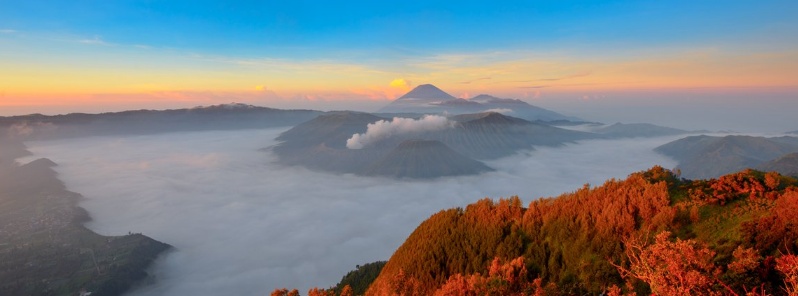Mount Bromo erupts, Aviation Color Code raised to Orange, Indonesia

Indonesian Mount Bromo erupted at 23:00 UTC on February 18, 2019 (06:00 local time, February 19), forcing authorities to raise the Aviation Color Code to Orange (previously unassigned). The Alert Level remains at Level 2 since 2016. The volcano has been erupting intermittently since 2015.
The eruption produced a thick white and brown column of ash, rising up to 2 929 m (9 393 feet) above sea level and drifting WSW. This is about 600 m (1 968 feet) above the crater rim.
Seismicity at the volcano is characterized by continuous volcanic tremor.
"According to the Bromo PVMBG, the mountain has been on Alert Level 2 [caution] since 2016 after its eruption in 2011. We are currently preparing to increase the alert level and security for Mt. Bromo visitors while coordinating with the central PVMBG," Bromo Tengger Semeru National Park (TNBTS) management head Jhon Kenedie said.
Visitors are prohibited from entering a 1 km (0.62 miles) radius from the park's craters. Kenedie said they can still enjoy nearby hills and panoramas.
Aktifitas Gunung #Bromo di Kabupaten Probolinggo Jawa Timur mengalami peningkatan. Meski gempa tremor masih dibawah 1 mili, disertai asap, menyembur dengan ketinggian 600 meter dari bibir kawah. Sampai saat ini, status gunung bromo #waspada level 2 jarak aman 1 kilometer. pic.twitter.com/YythvG9TJ6
— sketsanewscom (@sketsanewscom) February 19, 2019
Keluarkan awan panas gunung #bromo berstatus waspada pic.twitter.com/Cp2GgPpCnA
— Andik_Office (@andik_office) February 19, 2019
Bromo #bromo #mountbromo #Indonesia #gunungbromo pic.twitter.com/HrNn0ZeD29
— Djt's Gallery (@djtGallery) February 19, 2019
Mount Bromo in East Java erupted again this morning (19/02), sending a 600-meter column of volcanic ash into the sky. The volcano has been erupting intermittently since 2015 and authorities have declared a danger level of "standby." #bromo #ringoffire pic.twitter.com/b0M7EYgxyn
— The Jakarta Globe (@thejakartaglobe) February 19, 2019
Bromo's eruptions are usually characterized by continuous ash emissions reaching 1 000 m (3 280 feet) above the crater, occasionally followed by a burst of incandescent material up to 200 meters (650 feet).
The last time Bromo's activity was mentioned in GVP's Weekly Reports was in November 2016:
Based on analyses of satellite and webcam images and information from PVMBG, the Darwin VAAC reported that during November 10 – 12, ash plumes from Tengger Caldera’s Bromo cone rose to an altitude of 3 km (10 000 feet) a.s.l. and drifted NW, E, and SE.
Geological summary
The 16-km-wide (9.9 miles) Tengger caldera is located at the northern end of a volcanic massif extending from Semeru volcano. The massive volcanic complex dates back to about 820 000 years ago and consists of five overlapping stratovolcanoes, each truncated by a caldera. Lava domes, pyroclastic cones, and a maar occupy the flanks of the massif.
The Ngadisari caldera at the NE end of the complex formed about 150 000 years ago and is now drained through the Sapikerep valley.
The most recent of the calderas is the 9 x 10 km (5.6 x 6.2 miles) wide Sandsea caldera at the SW end of the complex, which formed incrementally during the late Pleistocene and early Holocene. An overlapping cluster of post-caldera cones was constructed on the floor of the Sandsea caldera within the past several thousand years.
The youngest of these is Bromo, one of Java's most active and most frequently visited volcanoes. (GVP)
Featured image credit: Djt's Gallery

Commenting rules and guidelines
We value the thoughts and opinions of our readers and welcome healthy discussions on our website. In order to maintain a respectful and positive community, we ask that all commenters follow these rules.